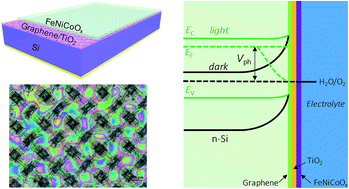当前位置:
X-MOL 学术
›
Sustain. Energy Fuels
›
论文详情
Our official English website, www.x-mol.net, welcomes your feedback! (Note: you will need to create a separate account there.)
Efficient photoelectrochemical water oxidation enabled by an amorphous metal oxide-catalyzed graphene/silicon heterojunction photoanode†
Sustainable Energy & Fuels ( IF 5.6 ) Pub Date : 2017-12-20 00:00:00 , DOI: 10.1039/c7se00504k Changli Li 1, 2, 3, 4, 5 , Yequan Xiao 1, 2, 3, 4, 5 , Li Zhang 1, 2, 3, 4, 5 , Yanbo Li 5, 6, 7, 8 , Jean-Jacques Delaunay 9, 10, 11, 12 , Hongwei Zhu 1, 2, 3, 4, 5
Sustainable Energy & Fuels ( IF 5.6 ) Pub Date : 2017-12-20 00:00:00 , DOI: 10.1039/c7se00504k Changli Li 1, 2, 3, 4, 5 , Yequan Xiao 1, 2, 3, 4, 5 , Li Zhang 1, 2, 3, 4, 5 , Yanbo Li 5, 6, 7, 8 , Jean-Jacques Delaunay 9, 10, 11, 12 , Hongwei Zhu 1, 2, 3, 4, 5
Affiliation

|
Silicon is a promising photoelectrochemical (PEC) material owing to its earth abundance, high carrier mobility and narrow bandgap. However, a bare Si photoelectrode is prone to photocorrosion and its photovoltage is affected by surface states on the electrode in PEC measurements. In the present work, a simple and inexpensive method for the construction of a Si/graphene heterojunction is presented. The high barrier at the solid/solid junction results in an open-circuit voltage of 490 mV, making it an excellent heterojunction light absorber to generate a substantial photovoltage for PEC water oxidation. A TiO2 thin layer deposited on the Si/graphene structure is effective to protect the heterojunction from the electrolyte while favoring the interfacial charge transport from the buried junction. The introduction of a FeNiCoOx co-catalyst thin film onto the TiO2 protected heterojunction yields a high photocurrent density of ∼19 mA cm−2 at an applied potential of 1.5 V vs. RHE in 1.0 M NaOH solution under one sun simulated solar illumination. In contrast to the unprotected Si/graphene electrode, the activity of the TiO2 protected photoanode is sustained for several hours in an alkaline electrolyte. This work clearly reveals the important role of graphene in the performance improvement of the Si-based photoanodes and sheds light on the introduction of novel materials onto silicon-based electrodes to achieve higher photovoltages for efficient PEC reactions.
中文翻译:

非晶态金属氧化物催化的石墨烯/硅异质结光阳极可实现高效的光电化学水氧化†
硅由于其地球丰度,高载流子迁移率和窄带隙而成为一种有前途的光电化学(PEC)材料。但是,裸露的Si光电极容易受到光腐蚀,在PEC测量中,其光电压会受到电极表面状态的影响。在当前的工作中,提出了一种简单且廉价的用于构造Si /石墨烯异质结的方法。固态/固态结处的高势垒导致490 mV的开路电压,使其成为出色的异质结光吸收剂,可为PEC水氧化生成大量的光电压。TiO 2沉积在Si /石墨烯结构上的薄层可有效保护异质结免受电解质的侵蚀,同时有利于从埋入式结中进行界面电荷传输。在一个太阳模拟的太阳光照下,在1.0 M NaOH溶液中施加1.5 V vs. RHE的条件下,在TiO 2保护的异质结上引入FeNiCoO x助催化剂薄膜可产生约19 mA cm -2的高光电流密度。。与未保护的Si /石墨烯电极相比,TiO 2的活性被保护的光阳极在碱性电解液中保持几个小时。这项工作清楚地揭示了石墨烯在改善硅基光阳极性能方面的重要作用,并为将新型材料引入硅基电极以实现更高的光电压以进行有效的PEC反应提供了启示。
更新日期:2017-12-20
中文翻译:

非晶态金属氧化物催化的石墨烯/硅异质结光阳极可实现高效的光电化学水氧化†
硅由于其地球丰度,高载流子迁移率和窄带隙而成为一种有前途的光电化学(PEC)材料。但是,裸露的Si光电极容易受到光腐蚀,在PEC测量中,其光电压会受到电极表面状态的影响。在当前的工作中,提出了一种简单且廉价的用于构造Si /石墨烯异质结的方法。固态/固态结处的高势垒导致490 mV的开路电压,使其成为出色的异质结光吸收剂,可为PEC水氧化生成大量的光电压。TiO 2沉积在Si /石墨烯结构上的薄层可有效保护异质结免受电解质的侵蚀,同时有利于从埋入式结中进行界面电荷传输。在一个太阳模拟的太阳光照下,在1.0 M NaOH溶液中施加1.5 V vs. RHE的条件下,在TiO 2保护的异质结上引入FeNiCoO x助催化剂薄膜可产生约19 mA cm -2的高光电流密度。。与未保护的Si /石墨烯电极相比,TiO 2的活性被保护的光阳极在碱性电解液中保持几个小时。这项工作清楚地揭示了石墨烯在改善硅基光阳极性能方面的重要作用,并为将新型材料引入硅基电极以实现更高的光电压以进行有效的PEC反应提供了启示。



























 京公网安备 11010802027423号
京公网安备 11010802027423号